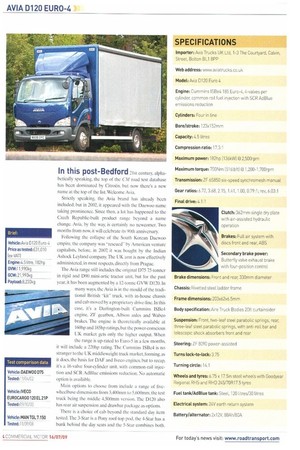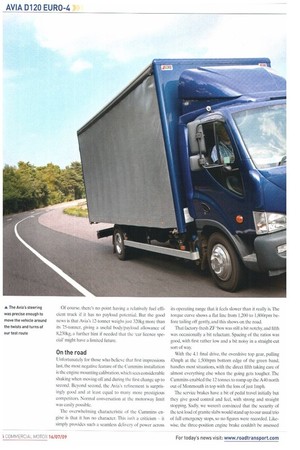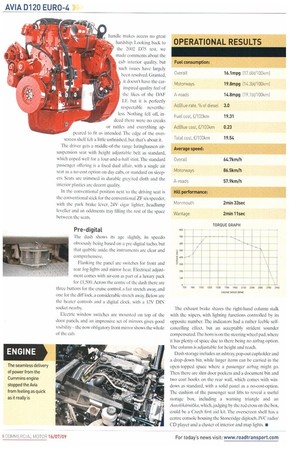In this post-Bedford 21st century, alphabetically speaking. the top of
Page 34

Page 35

Page 36

Page 37

Page 38

If you've noticed an error in this article please click here to report it so we can fix it.
the CM road test database has been dominated by Citroan, hut now there's a new name at the top of the list. Welcome Avia.
Strictly speaking, the Avia brand has already been included, but in 2002, it appeared with the Daewoo name taking prominence. Since then, a lot has happened to the Czech Republic-built product range beyond a name change. Avia, by the way, is certainly no newcomer. Two months from now; it will celebrate its 90th anniversary.
Following the collapse of the South Korean Daewoo empire. the company was "rescued" by American venture capitalists, before. in 2007, it was bought by the Indian Ashock Leyland company. The UK arm is now effectively administered, in most respects, directly from Prague.
The Avia range still includes the original D75 7.5-tonner in rigid and D90 mini-artic tractor unit, hut for the past year, it has been augmented by a 12-tonne CIVW D120. In many ways. the Avia is in the mould of the traditional British "kit" truck, with in-house chassis and cab moved by a proprietary drive-line. In this case, it's a Darlington-built Cummins 1SBe4 engine, ZF gearbox, Albion axles and Wabco brakes. The engine is theoretically available at 160hp and 185hp ratings, but the power-conscious UK market gets only the higher output. When
the range is up-rated to Euro-5 in a few months, it will include a 220hp rating. The Cummins ISBe4 is no stranger to the UK middleweight truck market, forming. as it does, the basis for DAF and Iveco engines, but to recap, it's a 16-valve four-cylinder unit, with common-rail injection and SCR AdBlue emissions reduction. No automatic option is available.
Main options to choose from include a range of fivewheelbase dimensions from 3,400mm to 5.600mm, the test truck being the middle 4,500mm version. The D120 also has rear air suspension and drawbar package as options.
There is a choice of cab beyond the standard day item tested. The 3-Star is a Pony roof-top pod, the 4-Star has a bunk behind the day seats and the 5-Star combines both. There's also a seven-seat crew-cab with three or four doors available if you so desire. The pain ishop at Avia's Prague factory is advanced, and any non-standard colour can be specified for £350, or £495 for metallic.
Although transaction prices are harder to gauge than usual, Avia's list price of £29,420 looks good against £38,670 for a comparable DAF LF45.
Productivity
Avia Trucks UK bravely put up a central demo vehicle for test with just 3,000km on the clock, something normally avoided by manufacturers because trucks rarely give their best until after at least 10 times that figure, and most of the contenders in this sector have dedicated press or demo fleet staff to ensure press test vehicles are giving their best.
rlbe Avia D120 came off demo the day before the test, leaving little time for any preparation beyond loading it up to maximum GVW. Its body wasn't a sleek aero-special. either,just a regular 20ft curtainsider from Aire, although it was matched to a sensible cab roof air management kit.
Frankly, we didn't expect any records to be set, not that one 12-tonner tested since 2002, an Iveco Euroeargo 210 in 2003, creates a vast databank for comparison. However, that Euro-3 example returned 15.7mpg overall, while the Daewoo D75, also Euro-3, tested in 2002, gave us 172mpg.
It was a pleasant surprise when a quick bit of mental arithmetic at the Magor services pumps showed a motorway figure knocking on the door of 20mpg, 19.8mpg as accurate calculations later revealed. It's not unusual for gearing anomalies to give a good motorway figure only to fall over on the slower second sector. But the D120 posted a sound showing with 14.8mpg on the A-roads combining to give an impressive 16.1mpg overall. Of course, AdBlue consumption has to be added, but the Cummins sipped the urea at a modest rate of 3% of diesel.
At 64.7krrilh, the Avia's average speed was slightly down on the last truck to negotiate our Welsh route, the MAN TC.IL 75-tonner. which returned 69.5km/h. Of course, there's no point having a relatively fuel efficient truck if it has no payload potential. But the good news is that Avi a's 12-tonner weighs just 320kg more than its 7.5-tonner, giving a useful body/payload allowance of 8,230kg, a further hint if needed that the 'car licence special' might have a limited future.
On the road
Unfortunately for those who believe that first impressions last, the most negative feature of the Cummins installation is the engine mounting calibration, which sees considerable shaking when moving off and during the first change up to second. Beyond second, the Avia's refinement is surprisingly good and at least equal to many more prestigious competitors. Normal conversation at the motorway limit was easily possible.
The overwhelming characteristic of the Cummins engine is that it has no character. This isn't a criticism — it simply provides such a seamless delivery of power across its operating range that it feels slower than it really is. The torque curve shows a flat line from 1,200 to 1,800rpm before tailing off gently, and this shows on the road.
That factory-fresh ZF 'box was still a bit notchy, and fifth was occasionally a bit reluctant. Spacing of the ratios was good, with first rather low and a bit noisy in a straight-cut sort of way.
With the 4.1 final drive, the overdrive top gear, pulling 43mph at the 1,500rpm bottom edge of the green band, handles most situations, with the direct fifth taking care of almost everything else when the going gets tougher. The Cummins enabled the 12 tonnes to romp up the A40 north out of Monmouth in top with the loss of just lmph.
The service brakes have a bit of pedal travel initially but they give good control and feel, with strong and straight stopping. Sadly, we weren't convinced that the security of the test load of granite slabs would stand up to our usual trio of full emergency stops, so no figures were recorded. Likewise, the three-position engine brake couldn't be assessed because of an electrical glitch, but when working properly, it has over-run and service brake blending functions
The twin-leaf parabolic front suspension had a tendency to crash out on bumps, a characteristic not uncommon even on more prestigious rivals, which we can only assume is due to Continental engineers having a higher regard for UK roads than is deserved. Ours also delivered a, hopefully not normal, bump under the driver's feet if a major imperfection was met with the steering partly turned.
The steering exhibited more than enough precision for negotiating narrow twists in comfort, but if you regularly find yourself delivering full loads to Milton Keynes, a bit more assistance would be welcome on the roundabouts.
For daily maintenance, the engine oil dipstick was moved to the front grille at the request of a certain large fleet operator of red lorries and then kept as a standard feature. For more involved engine access, the cab manual tilt is the work of a few moments.
handle makes access no great hardship. Looking back to the 2002 D75 test, we made comments about the cab interior quality, but such issues have largely been resolved. Granted, it doesn't have the carinspired quality feel of the likes of the DAF LF, but it is perfectly respectable nevertheless Nothing fell off, indeed there were no creaks or rattles and everything appeared to fit as intended. The edge of the overscreen shelf felt a little unfinished, hut that's about it. The driver gets a middle-of-the range lsringhausen air suspension seat with height adjustable belt as standard, which coped well for a four-and-a-half stint. The standard passenger offering is a fixed dual affair, with a single air seat as a no-cost option on day cabs, or standard on sleepers. Seats are trimmed in durable grey/red cloth and the interior plastics arc decent quality.
In the conventional position next to the driving seat is the conventional stick for the conventional ZF six-speeder, with the park brake lever, 24V cigar lighter, headlamp leveller and an oddments tray filling the rest of the space between the seats
Pre-digital
The dash shows its age slightly, its speedo obviously being based on a pre-digital tacho, but that quibble aside, the instruments are clear and comprehensive.
Flanking the panel are switches for front and rear fog-lights and mirror heat. Electrical adjust ment comes with air-con as part of a luxury pack for 1:1,500. Across the centre of the dash there are three buttons for the cruise control, a fair stretch away, and one for the diff lock, a considerable stretch away. Below are the heater controls and a digital clock, with a 12V DIN socket nearby.
Electric window switches are mounted on top of the door panels, and an impressive set of mirrors gives good visibility — the now obligatory front mirror shows the whole of the cab. The exhaust brake shares the right-hand column stalk with the wipers, with lighting functions controlled by its opposite number. The indicators had a rather feeble selfcancelling effect, but an acceptably strident sounder compensated.The horn is on the steering wheel pad. where it has plenty of space due to there being no airbag option. The column is adjustable for height and reach.
Dash storage includes an ashtray, pop-out cupholder and a drop-down bin, while larger items can be carried in the open-topped space where a passenger airbag might go. Then there are slim door pockets and a document bin and two coat hooks on the rear wall, which comes with windows as standard, with a solid panel as a no-cost-option. The cushion of the passenger seat lifts to reveal a useful storage box, including a warning triangle and an Autolikarnialui,which,judging by the red cross on the box, could he a Czech first aid kit. The overscreen shelf has a centre console housing the Stoneridge digitach, WC radio/ CD player and a cluster of interior and map lights •




















































































































































